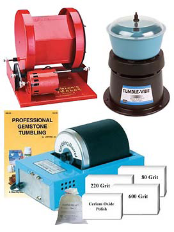How to Choose a Rock Tumbler Are you in the market for a rock tumbler, but not sure what type to buy? The type of rock polisher you'll need depends on the work you're doing and what kind of rocks you'll be polishing. Most rock tumblers are rated by weight capacity. For example, a three-pound tumbler will rotate three pounds of weight indefinitely. To polish rocks that measure 1.5 diameter inches or more, or to polish several rocks at once, choose a large rock polisher with at least a six-pound capacity. To polish smaller stones, or to tumble a few rocks at a time, a small machine should work just fine. Three-pound capacity or smaller tumbler will get the job done easily. Be careful not to overload your machine or the motor will burn out.
Rotary Rock Tumblers. A rotary rock tumbler is also known as a standard rock tumbler and is used by hobbyists and professionals alike. A rotary tumbler has a system of barrels that rotate around a metal cylinder to tumble and polish the rocks inside. It's easy to use and creates smooth, polished stones in 30 to 45 days. Rocks often come out with a rounded shape regardless of what they looked like when they went in. Small rocks and grit go into the cylinder. Gradually, the surfaces of the rocks are smoothed away, resulting in round, polished stones. Rotary rock tumblers come in a variety of sizes. Choose one with cylinders that are large enough to hold the amount of rocks you plan to tumble at one time. Good quality, heavy duty rotary rock tumblers should be made almost entirely of metal. Most smaller models will have enclosed motors, which are somewhat quieter to run. Rotary rock tumblers are fairly inexpensive compared to other types of tumblers, such as vibrating ones. Vibrating Rock Polishers. A vibrating rock tumbler works in a slightly different way. It doesn't actually "tumble" the rock. Instead, the cylinder that holds the rocks vibrates - creating friction between the rocks and the grit material. Because the rocks are moving less, they are polished much more quickly than with a rotary tumbler, usually within 7-10 days. A vibrating tumbler polishes, but does not change the shape of your stones. Some rock hounds consider this to be an advantage because it's easy to create beautiful, variegated polished stones with natural shapes. Vibrating tumblers use less grit and polish, meaning you'll save money, especially if you're tumbling a lot of rocks. But they can also be noisier to operate, and they do require more constant maintenance since the grit must be changed approximately every 12 hours. As you can see, there is no single "right" tumbler for lapidaries. But no matter if you choose a rotary or vibrating machine, if you are planning on using it more than a few times, it's worth the cost to buy the highest-quality rock polisher you can afford to ensure that you're not constantly having to replace parts or invest money in repairs. Click here to learn How to Start Rock Tumbling Click here for Rock Picks and Shovels |
|
|

